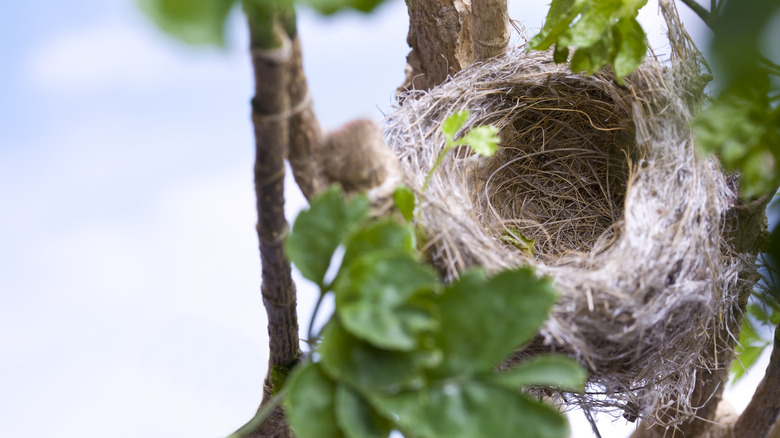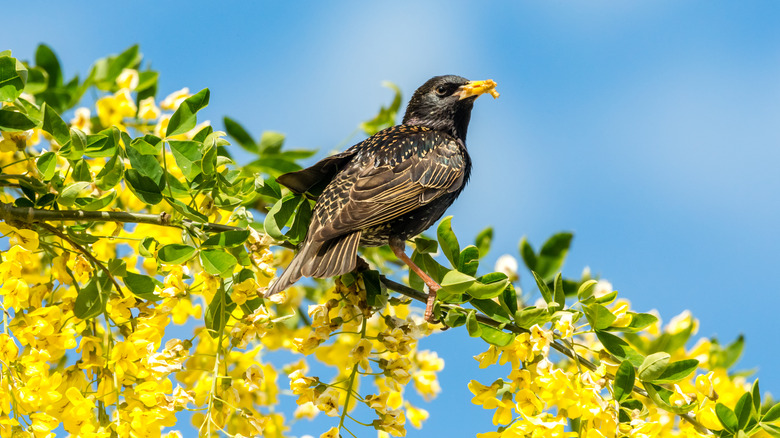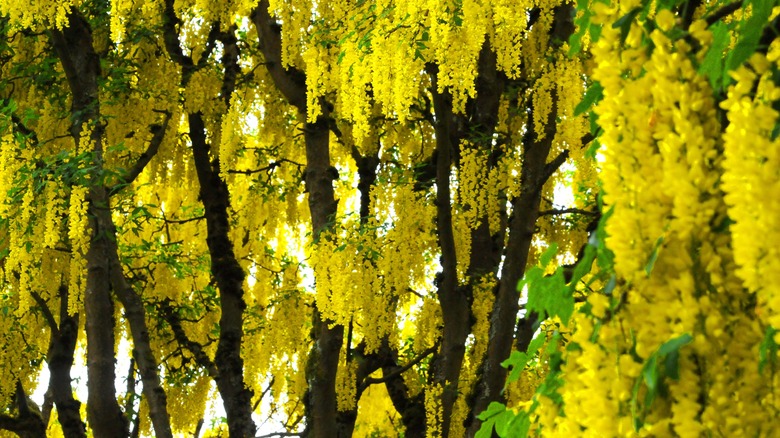Provide A Bird Nest Haven With A Beautiful Golden Tree
One of the most show-stopping trees, the golden chain tree (Laburnum spp.), blooms with gorgeous yellow flowers, putting on an incredible show in spring. Laburnum is a genus consisting of two species of shrubs and trees in the Fabaceae, or pea, family. Not only does it offer spectacular blooms with ornamental appeal, but it also has dense foliage and sturdy branches, encouraging birds to build nests. Although it's unclear if birds enjoy the fruit, the tree's flowers attract insects for our feathered friends to snack on.
Growing up to 30 feet tall and wide, you can grow Laburnum as a small tree or as a large shrub. You can even trim and shape the golden chain tree to form a flowering hedge to use as a border plant. It's important to note that all parts of these plants are poisonous to humans, pets, and livestock. Wearing a pair of gardening gloves, remove the uninteresting seed pods when they appear to prevent any curious children or pets from mistaking their toxic fruit for a treat. The entire tree is toxic, including the bark, leaves, and roots, so plant with caution if you think any animals you own may try to ingest any fallen debris. Birds, on the other hand, enjoy calling this tree home. Let's get into why our favorite colorful visitors flock to the golden chain tree.
Why birds love this golden tree
Most gardeners agree that birds are fascinating creatures; watching them can provide hours of entertainment. If you want to attract birds to your garden, you'll want to create an environment that caters to their basic needs: shelter, food, and water. The golden chain tree has all three attributes, making it an appealing place to build a nest. Its dense foliage protects its young from predators by keeping the structure out of direct view. Additionally, predators may steer clear of this plant due to its poisonous nature, offering an even safer haven.
Laburnum has an upright growth habit, so when properly pruned and cared for, these trees won't break apart easily, providing a sturdy structure for birds to nest. As the hatchlings grow, birds can turn to several insects that are fond of the golden chain tree, like the Genista caterpillar. Additionally, the flowers and leaves will collect rainwater, so our avian visitors can easily access water. That said, adding a birdbath to your garden will give them additional opportunities to drink and bathe. Keep your birdbath clean and place it near your Laburnum tree to further encourage them to take up residence in your yard.
Caring for golden chain trees
Hardy in zones 5B through 7, Laburnum can be a little high-maintenance, but its dense chains of vibrant yellow blooms and appeal to birds may make it worth it. Although it prefers full sun, the golden chain tree needs some protection during the harsh rays in the afternoon, especially in winter. While it may enjoy a little sunshine, this tree cannot tolerate intense heat and humidity and prefers moderate temperatures year-round. It needs extremely well-drained, loamy, or sandy soil rich in organic matter and does not tolerate standing water. Once established, Laburnums are moderately drought-tolerant and rarely need supplemental water, so be cautious to avoid overwatering.
To properly care for a golden chain tree, you'll need to prune it regularly to maintain its strong structure. Some experts recommend pruning at the end of the flowering season in late summer, while others suggest trimming it up closer to winter when it goes dormant. Any time within this time frame is fine, though you should avoid making any cuts in spring or early summer, as it could lead to potential infections. That said, all plants in this species are prone to a few pests and diseases. Although insects like aphids and mealybugs can make good snacks for birds, they can damage your Laburnum. Other issues to look out for include canker, twig blight, leaf spot, Laburnum vein mosaic, silver leaf, and powdery mildew.


